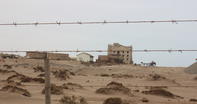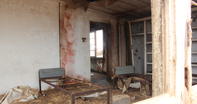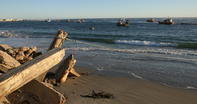Diamondiferous Deposits
Over the decades that followed, Alexcor built a town at Alexander Bay which was, until recently, highly restricted. De Beers expanded their operations from Kleinzee to include the Koingnaas Complex, near Hondeklip Bay.

In the 1960s, a new company was formed and it secured leases along the southern banks of the Orange River. This became the TransHex Corporation, which now mines at Baaken and Reuning (at the entrance to the Richtersveld National Park). Most of these mines did exceedingly well.
The De Beers mines alone recovered 31 million carats in 75 years. At Reuning, a 43 metre deep splash pool formed by the Orange River collected a glut of diamondiferous deposits with as much as 41 carats per 100 tons of gravel. This so-called ‘Glory Hole’ yielded diamonds worth a modern equivalent of R4 billion.
Sea Diamond Mining

But those ‘glory’ days are in the past. Today, the on-shore diamond fields are almost worked out and attention has shifted to the marine deposits. The exploitation of underwater diamonds began with a Texan, Sam Collins, who had a company that specialised in submarine pipelines.
In the early 1960s, Collins heard a story about a farmer who was pumping up diamondiferous gravel off the Namibian coastline. He leapt into action, bought the farmer’s concession and started working out new ways to profitably suck up the sand from the sea bed. Obviously, De Beers kept a close eye on Collins’ operation and, as soon as they saw that the scheme was payable, they bought him out in 1965.
A slump in diamond prices caused De Beer’s to abandon the sea-diamond enterprise in 1971, but prospecting continued. Then, in the early 1990s, sea-diamond mining started up again because the supply of on-shore diamonds was drying up.
Diamond Boats

Today, sea diamonds are big business. In 2003, for example, a team near Alexander Bay found the Cirrus Diamond, a fabulous 111-carat gemstone, which must have got people very excited! Nevertheless, Alexkor and De Beers no longer operate their own sea-diamond boats. Instead, they have divided up their respective ocean areas and assigned them to independent contractors on a concession basis.
These ‘blocks’ are now worked by small diamond boats, which suck up gravel from the seabed through a big tube operated by a diver. Once on the boat, the gravel is packed into sacks and sent to on-shore sorting facilities. The diamond boats have become a valuable source of employment in an impoverished region, although rough sea conditions and adverse weather limits the number of days that boats can go out.
Despite the success of the sea diamond operations, the output of the on-shore mines continue to dwindle and most have a life expectancy of 5 to 10 years. With the imminent closure of these mines, there is a question of what to do next. Alexander Bay has already opened its gates to visitors, as has the private town of Kleinzee.
It is hoped that tourism will step in and fill the economic gap left by the departing diamond mines. After all, the extensive land holdings of the various mining operations have ensured that the coast is in a pristine condition and, the area should offer some unique leisure activities.
By David Fleminger